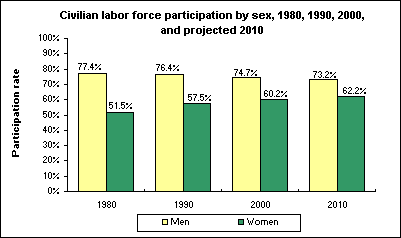December 18, 2001 (The Editor’s Desk is updated each business day.)
Labor force participation trends for women and men
The labor force participation rate for women rose about 9 percentage points between 1980 and 2000 and is projected to rise further between 2000 and 2010. In contrast, the rate for men fell between 1980 and 2000 and is projected to fall again in the 2000-2010 period.

[Chart data—TXT]
The labor force participation rate for women grew from 51.5 percent in 1980 to 60.2 percent in 2000 and is projected to reach 62.2 percent in 2010. By age, women 45 to 54 had the largest percentage-point increase in labor force participation between 1980 and
2000—from 59.9 percent to 76.8 percent; in 2010, this rate is projected to rise to 80.0 percent.
The rate for men has been declining, from 77.4 percent in 1980 to 74.7 percent in 2000, and is projected to reach 73.2 percent in 2010. By age, men 16 to 19 had the biggest percentage-point decline in participation between 1980 and
2000—from 60.5 percent to 53.0 percent; in 2010, this rate is projected to be 52.3 percent.
These data are from the BLS Employment Projections
program. For more information, see "Labor
force projections to 2010: steady growth and changing composition,"
by Howard N Fullerton, Jr. and Mitra Toossi, Monthly Labor Review,
November 2001. (The BLS employment projections for the period 2000-2010
were completed prior to the tragic events of September 11, 2001. BLS will
continue to review its projections and, as the long-term consequences of
September 11 become clearer, will incorporate these effects in subsequent
analyses of industrial and occupational outlook.)
Related TED articles:
Of interest
Spotlight on Statistics: National Hispanic Heritage Month
In this Spotlight, we take a look at the Hispanic labor force—including labor force participation, employment and unemployment, educational attainment, geographic location, country of birth, earnings, consumer expenditures, time use, workplace injuries, and employment projections.
.
Read more »
